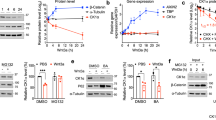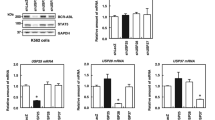Abstract
Ubiquitination plays a major role in many aspects of hematopoiesis. Alterations in ubiquitination have been implicated in hematological cancer. The ubiquitin ligase Triad1 controls the proliferation of myeloid cells. Here, we show that two RING (really interesting new gene) domains in Triad1 differentially bind ubiquitin-conjugating enzymes, UbcH7 and Ubc13. UbcH7 and Ubc13 are known to catalyze the formation of different poly-ubiquitin chains. These chains mark proteins for proteasomal degradation or serve crucial non-proteolytic functions, respectively. In line with the dual Ubc interactions, we observed that Triad1 catalyzes the formation of both types of ubiquitin chains. The biological relevance of this finding was studied by testing Triad1 mutants in myeloid clonogenic assays. Full-length Triad1 and three mutants lacking conserved domains inhibited myeloid colony formation by over 50%. Strikingly, deletion of either RING finger completely abrogated the inhibitory effect of Triad1 in clonogenic growth. We conclude that Triad1 exhibits dual ubiquitin ligase activity and that both of its RING domains are crucial to inhibit myeloid cell proliferation. The differential interaction of the RINGs with Ubcs strongly suggests that the ubiquitination mediated through UbcH7 as well as Ubc13 plays a major role in myelopoiesis.
This is a preview of subscription content, access via your institution
Access options
Subscribe to this journal
Receive 12 print issues and online access
$259.00 per year
only $21.58 per issue
Buy this article
- Purchase on Springer Link
- Instant access to full article PDF
Prices may be subject to local taxes which are calculated during checkout







Similar content being viewed by others
References
Fang S, Weissman AM . A field guide to ubiquitylation. Cell Mol Life Sci 2004; 61: 1546–1561.
Marteijn JA, Jansen JH, van der Reijden BA . Ubiquitylation in normal and malignant hematopoiesis: novel therapeutic targets. Leukemia 2006; 20: 1511–1518.
Pastore Y, Jedlickova K, Guan Y, Liu E, Fahner J, Hasle H et al. Mutations of von Hippel–Lindau tumor-suppressor gene and congenital polycythemia. Am J Hum Genet 2003; 73: 412–419.
D'Andrea AD, Grompe M . The Fanconi anaemia/BRCA pathway. Nat Rev Cancer 2003; 3: 23–34.
Bueso-Ramos CE, Yang Y, deLeon E, McCown P, Stass SA, Albitar M . The human MDM-2 oncogene is overexpressed in leukemias. Blood 1993; 82: 2617–2623.
Caligiuri MA, Briesewitz R, Yu J, Wang L, Wei M, Arnoczky KJ et al. Novel c-CBL and CBL-b ubiquitin ligase mutations in human acute myeloid leukemia. Blood 2007; 110: 1022–1024.
Zeng S, Xu Z, Lipkowitz S, Longley JB . Regulation of stem cell factor receptor signaling by Cbl family proteins (Cbl-b/c-Cbl). Blood 2005; 105: 226–232.
Glickman MH, Ciechanover A . The ubiquitin–proteasome proteolytic pathway: destruction for the sake of construction. Physiol Rev 2002; 82: 373–428.
Marteijn JA, van Emst L, Erpelinck-Verschueren CA, Nikoloski G, Menke A, de Witte T et al. The E3 ubiquitin-protein ligase Triad1 inhibits clonogenic growth of primary myeloid progenitor cells. Blood 2005; 106: 4114–4123.
Lorick KL, Jensen JP, Fang S, Ong AM, Hatakeyama S, Weissman AM . RING fingers mediate ubiquitin-conjugating enzyme (E2)-dependent ubiquitination. Proc Natl Acad Sci USA 1999; 96: 11364–11369.
Deng L, Wang C, Spencer E, Yang L, Braun A, You J et al. Activation of the IkappaB kinase complex by TRAF6 requires a dimeric ubiquitin-conjugating enzyme complex and a unique polyubiquitin chain. Cell 2000; 103: 351–361.
Eddins MJ, Carlile CM, Gomez KM, Pickart CM, Wolberger C . Mms2–Ubc13 covalently bound to ubiquitin reveals the structural basis of linkage-specific polyubiquitin chain formation. Nat Struct Mol Biol 2006; 13: 915–920.
Sun L, Chen ZJ . The novel functions of ubiquitination in signaling. Curr Opin Cell Biol 2004; 2: 119–126.
Hoege C, Pfander B, Moldovan GL, Pyrowolakis G, Jentsch S . RAD6-dependent DNA repair is linked to modification of PCNA by ubiquitin and SUMO. Nature 2002; 419: 135–141.
Wu CJ, Conze DB, Li T, Srinivasula SM, Ashwell JD . Sensing of Lys 63-linked polyubiquitination by NEMO is a key event in NF-kappaB activation. Nat Cell Biol 2006; 8: 398–406.
Ben-Saadon R, Zaaroor D, Ziv T, Ciechanover A . The polycomb protein Ring1B generates self atypical mixed ubiquitin chains required for its in vitro histone H2A ligase activity. Mol Cell 2006; 24: 701–711.
Kim HT, Kim KP, Lledias F, Kisselev AF, Scaglione KM, Skowyra D et al. Certain pairs of ubiquitin-conjugating enzymes (E2s) and ubiquitin-protein ligases (E3s) synthesize nondegradable forked ubiquitin chains containing all possible isopeptide linkages. J Biol Chem 2007; 282: 17375–17386.
Peng J, Schwartz D, Elias JE, Thoreen CC, Cheng D, Marsischky G et al. A proteomics approach to understanding protein ubiquitination. Nat Biotechnol 2003; 21: 921–926.
Marteijn JA, van der Meer LT, van Emst L, van RS, Wissink W, de Witte T et al. Gfi1 ubiquitination and proteasomal degradation is inhibited by the ubiquitin ligase Triad1. Blood 2007; 110: 3128–3135.
Nigten J, Breems-de Ridder MC, Erpelinck-Verschueren CA, Nikoloski G, van der Reijden BA, van Wageningen S et al. ID1 and ID2 are retinoic acid responsive genes and induce a G0/G1 accumulation in acute promyelocytic leukemia cells. Leukemia 2005; 19: 799–805.
Marteijn JA, van der Meer LT, van Emst L, de Witte T, Jansen JH, van der Reijden BA . Diminished proteasomal degradation results in accumulation of Gfi1 protein in monocytes. Blood 2007; 109: 100–108.
van der Reijden BA, Simons A, Luiten E, van der Poel SC, Hogenbirk PE, Tonnissen E et al. Minimal residual disease quantification in patients with acute myeloid leukaemia and inv(16)/CBFB-MYH11 gene fusion. Br J Haematol 2002; 118: 411–418.
Ito K, Adachi S, Iwakami R, Yasuda H, Muto Y, Seki N et al. N-terminally extended human ubiquitin-conjugating enzymes (E2s) mediate the ubiquitination of RING-finger proteins, ARA54 and RNF8. Eur J Biochem 2001; 268: 2725–2732.
Doss-Pepe EW, Chen L, Madura K . Alpha-synuclein and parkin contribute to the assembly of ubiquitin lysine 63-linked multiubiquitin chains. J Biol Chem 2005; 280: 16619–16624.
Zhang M, Windheim M, Roe SM, Peggie M, Cohen P, Prodromou C et al. Chaperoned ubiquitylation--crystal structures of the CHIP U box E3 ubiquitin ligase and a CHIP–Ubc13–Uev1a complex. Mol Cell 2005; 20: 525–538.
Plans V, Scheper J, Soler M, Loukili N, Okano Y, Thomson TM . The RING finger protein RNF8 recruits UBC13 for lysine 63-based self polyubiquitylation. J Cell Biochem 2006; 97: 572–582.
Hofmann RM, Pickart CM . Noncanonical MMS2-encoded ubiquitin-conjugating enzyme functions in assembly of novel polyubiquitin chains for DNA repair. Cell 1999; 96: 645–653.
Morett E, Bork P . A novel transactivation domain in parkin. Trends Biochem Sci 1999; 24: 229–231.
van der Reijden BA, Erpelinck-Verschueren CA, Lowenberg B, Jansen JH . TRIADs: a new class of proteins with a novel cysteine-rich signature. Protein Sci 1999; 8: 1557–1561.
Lovering R, Hanson IM, Borden KL, Martin S, O'Reilly NJ, Evan GI et al. Identification and preliminary characterization of a protein motif related to the zinc finger. Proc Natl Acad Sci USA 1993; 90: 2112–2116.
Martinez-Noel G, Muller U, Harbers K . Identification of molecular determinants required for interaction of ubiquitin-conjugating enzymes and RING finger proteins. Eur J Biochem 2001; 268: 5912–5919.
Moynihan TP, Ardley HC, Nuber U, Rose SA, Jones PF, Markham AF et al. The ubiquitin-conjugating enzymes UbcH7 and UbcH8 interact with RING finger/IBR motif-containing domains of HHARI and H7-AP1. J Biol Chem 1999; 274: 30963–30968.
Shimura H, Hattori N, Kubo S, Mizuno Y, Asakawa S, Minoshima S et al. Familial Parkinson disease gene product, parkin, is a ubiquitin-protein ligase. Nat Genet 2000; 25: 302–305.
Capili AD, Edghill EL, Wu K, Borden KL . Structure of the C-terminal RING finger from a RING-IBR-RING/TRIAD motif reveals a novel zinc-binding domain distinct from a RING. J Mol Biol 2004; 340: 1117–1129.
Lim KL, Dawson VL, Dawson TM . Parkin-mediated lysine 63-linked polyubiquitination: a link to protein inclusions formation in Parkinson's and other conformational diseases? Neurobiol Aging 2006; 27: 524–529.
Olzmann JA, Li L, Chudaev MV, Chen J, Perez FA, Palmiter RD et al. Parkin-mediated K63-linked polyubiquitination targets misfolded DJ-1 to aggresomes via binding to HDAC6. J Cell Biol 2007; 178: 1025–1038.
Hampe C, Ardila-Osorio H, Fournier M, Brice A, Corti O . Biochemical analysis of Parkinson's disease-causing variants of Parkin, an E3 ubiquitin-protein ligase with monoubiquitylation capacity. Hum Mol Genet 2006; 15: 2059–2075.
Matsuda N, Kitami T, Suzuki T, Mizuno Y, Hattori N, Tanaka K . Diverse effects of pathogenic mutations of Parkin that catalyze multiple monoubiquitylation in vitro. J Biol Chem 2006; 281: 3204–3209.
Pickart CM, Raasi S . Controlled synthesis of polyubiquitin chains. Methods Enzymol 2005; 399: 21–36.
Acknowledgements
We thank Dr Knipscheer, Dr Notenboom (Dutch Cancer Institute, Amsterdam, The Netherlands) for large-scale His-Triad1 production and Ubc13–Mms2, respectively, Dr Thomsom (Institut de Biologia Molecular de Barcelona, CSIC, Barcelona, Spain) for sharing the Ubc13-flag construct, Dr Timmers (University Medical Center, Utrecht, The Netherlands) for UbcH7.
This work was supported by grants of the Dutch Cancer Society (KUN2001-2395) and the Vanderes Foundation.
Author information
Authors and Affiliations
Corresponding author
Additional information
Supplementary information accompanies the paper on the Leukemia website (http://www.nature.com/leu)
Rights and permissions
About this article
Cite this article
Marteijn, J., van der Meer, L., Smit, J. et al. The ubiquitin ligase Triad1 inhibits myelopoiesis through UbcH7 and Ubc13 interacting domains. Leukemia 23, 1480–1489 (2009). https://doi.org/10.1038/leu.2009.57
Received:
Revised:
Accepted:
Published:
Issue Date:
DOI: https://doi.org/10.1038/leu.2009.57
Keywords
This article is cited by
-
The roles of ubiquitination in AML
Annals of Hematology (2023)
-
ARIH2 regulates the proliferation, DNA damage and chemosensitivity of gastric cancer cells by reducing the stability of p21 via ubiquitination
Cell Death & Disease (2022)
-
The expression of TRIAD1 and DISC1 after traumatic brain injury and its influence on NSCs
Stem Cell Research & Therapy (2018)
-
ARIH2 is essential for embryogenesis, and its hematopoietic deficiency causes lethal activation of the immune system
Nature Immunology (2013)
-
The E3 ligase HOIP specifies linear ubiquitin chain assembly through its RING-IBR-RING domain and the unique LDD extension
The EMBO Journal (2012)



